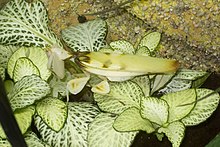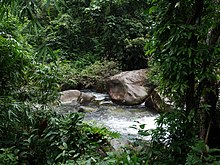Yellow orchid mantis
| Yellow orchid mantis | ||||||||||||
|---|---|---|---|---|---|---|---|---|---|---|---|---|

Yellow orchid mantis ( Helvia cardinalis ), female |
||||||||||||
| Systematics | ||||||||||||
|
||||||||||||
| Scientific name of the genus | ||||||||||||
| Helvia | ||||||||||||
| Stål , 1877 | ||||||||||||
| Scientific name of the species | ||||||||||||
| Helvia cardinalis | ||||||||||||
| Stål, 1877 |
The Yellow Orchideenmantis ( Helvia cardinalis , synonym : Parymenopus davisoni ) is a Mantis from the family of Hymenopodidae and the only way to thus monotypic genus Helvia . The Southeast Asian species has been relatively little researched. The male was described by Carl Stål as early as 1877 . The female was first described by James Wood-Mason in 1890 , albeit under the different genus and species name Parymenopus davisoni. The association of the two "species" was not recognized until 2015.
features

The females of the yellow orchid mantis reach a body length of 45 mm, the males one of 35 mm, making the yellow orchid mantis a smaller representative of the mantis. The basic color of the species is Indian yellow . The yellow orchid mantis, like many species of the Hymenopodidae family, is one of the flower imitators. The eyes of the species are tapered and the thorax (chest section) comparatively short. The yellow orchid mantis lingers in the presence of a strong sexual dimorphism (difference between the sexes) with many terrors .
female
The pronotum , a heavily sclerotized plate of the first breast segment of the female, is weakly granulated and slightly serrated on both sides. These teeth get smaller in the direction of the taper of the pronotum until they disappear completely. The thorax has a brown markings, including a V-shaped spot in the center, and a black line below, which merges into another nearly semicircular spot at the rear edge of the thorax at the transition between the thorax (chest) and abdomen (abdomen). There is a brown dot in the center of the thorax and brown lines along its rear edge, each covering part of this area. The prosternum (the foremost section of the sternum or the chest plate of the thorax) is slightly lighter in color and also has a brown spot that is almost crescent-shaped. This spot is directed forward and begins at the base of the canine bones , extends over the edge of the thorax and extends to the rear corners of the pronotum.
The legs of the female contain light red tones and have leaf-like lobes on the tibia (greaves) near the transition to the femora (thighs) that are not wider than 1.5 millimeters. The wings protrude about a sixth of the abdomen. The tegmina (wing wings) are three times as long as they are wide and taper towards the rear. Their edges are leathery, translucent and vermilion in color. Otherwise the tegmina are partly translucent and have a yellow basic color, similar to the body. In addition, they show three translucent and six radial, green dots, which are arranged in pairs in three rows. The two front ones are smaller and also appear a little brownish. The rear pair of wings is clearly more pointed and more translucent than the tegmina towards the end. The wings are cream-colored, although the outer edge of the wings appears red-yellow and takes on a darker hue towards the rear. The wings of the female are too short and, like most fishing horrors, do not give them good flight ability. The abdomen of the female is brown-yellow and consists of six segments that have no markings.
male
The smaller male of the yellow orchid mantis shows a much weaker basic color and less contrasting drawing than the female. It is built more narrowly and, unlike the female, has eight abdominal segments. The male has a concave shaped thorax and longer wings and is therefore a good flyer in contrast to the female. This gender-specific difference in flight ability is found in most fishing fright.
Similar species

The yellow orchid mantis is similar to the related and much better known orchid mantis ( Hymenopus coronatus ), which also belongs to the Hymenopodidae family . The yellow orchid mantis differs from this one, however, apart from the smaller size and yellow color, due to the smaller lobes on the legs, the lack of the eye hump in females and the shorter thorax.
Occurrence

The yellow orchid mantis is common on the Malay Peninsula , Sumatra and Borneo . Within these areas it inhabits the rainforests . It prefers to live on the flowers of various plants in rainforests, where it can camouflage itself well. Fishing rods that have various adaptations to this way of life are known as flower mantids.
Threat and protection
There is no information about possible threats to the population of the yellow orchid mantis, as their populations are not recorded by the IUCN .
Way of life
Like many terrors , the yellow orchid mantis is a lurker who behaves largely motionless in its habitat and quickly grabs potential prey with its thorny tentacles. The prey scheme mostly includes arthropods of appropriate size.
Reproduction
The courtship and mating behavior of the yellow orchid mantis are identical to those of other fishing horrors. The actual pairing can take three to four hours to complete. About four weeks after being deposited, about 15 to 30 young animals hatch from the fertilized oothecae. These are initially four millimeters long and have an orange-black appearance, which, like the larvae of many fishing horrors, imitates ants , as these are avoided by many potential predators. One speaks here of mimicry .
Terrariums
The yellow orchid mantis is kept as a pet in terraristics because of its distinctive appearance, like many fishing horrors , but it is less well known than the orchid mantis ( Hymenopus coronatus ). However, keeping one or more specimens of the yellow orchid mantis is only recommended to owners with experience, as the species depends on the precise compliance with various parameters such as temperature and humidity and can also be more sensitive to complications such as mold growth . As with all rainforest inhabitants, the temperature and humidity of their natural habitat must be simulated as well as possible for successful keeping.
Systematics
The yellow orchid mantis was first described by Carl Stål in 1877 using a male as Helvia cardinalis and is also the only and therefore the type species of the monotypic genus Helvia . The species first described by James Wood-Mason in 1890 as Parymenopus davisoni is the female of the species. The male of Parymenopus davisoni was also described in 1933, but corresponds to the somewhat forgotten description by Carl Stål. Christian J. Schwarz discovered the equality of the two species in 2015 and took over the older name Helvia cardinalis because of the priority rule of the ICZN . The scientific name Parymenopus davisoni , which is therefore considered a synonym, is still frequently used for the yellow orchid mantis .
Individual evidence
- ↑ a b c d e f g Parymenopus davisoni (Wood-Mason, 1890) on Mantopedia, accessed March 20, 2020.
- ↑ a b c d e f The Annals and magazine of natural history; zoology, botany, and geology , 6th ser. v. 5, London, Taylor and Francis, 1890, pp. 436-437, Ltd, accessed March 20, 2020.
- ↑ a b c d Christian J. Schwarz: https://www.naturkundemuseum-bw.de/sites/default/files/publikationen/serie-a/sb_8-05_schwarz.pdf , Stuttgart contributions to natural history A, New Series 8, 2015, pp. 49–52, accessed on March 20, 2020.
- ↑ Helvia cardinalis (Stål, 1877) on Global Biodiversity Information Facility , accessed on March 20, 2020.
- ↑ Helvia cardinalis (Stål, 1877) on Mantodea Species File, accessed March 20, 2020.
literature
- The Annals and magazine of natural history; zoology, botany, and geology , 6th ser. v. 5, London, Taylor and Francis, 1890, pp. 436-437.
- Christian J. Schwarz: Parymenopus davisoni Wood-Mason synonym of Helvia cardinalisStål (Insecta: Mantodea: Hymenopodidae) , Stuttgart Contributions to Natural History A, New Series 8, 2015, pp. 49–52.
Web links
- Helvia cardinalis (Stål, 1877) on Global Biodiversity Information Facility
- Helvia cardinalis (Stål, 1877) on Mantodea Species File
- Parymenopus davisoni (Wood-Mason, 1890) on Mantopedia